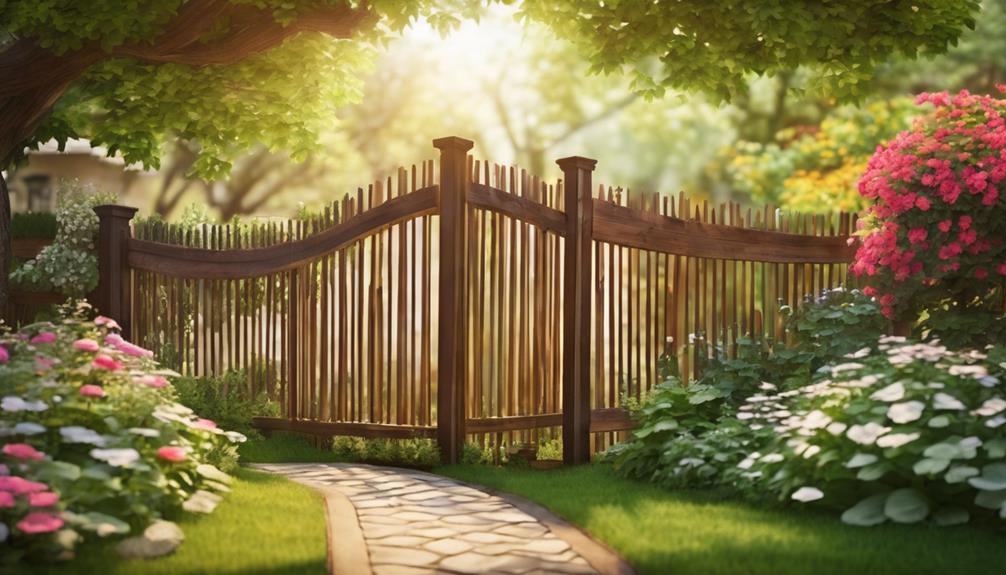
Stylish Container Garden Ideas for Patios
15 February 2025
7 Tips for Seasonal Garden Cleanup Services
15 February 2025Expert fencing solutions for garden boundaries combine security and aesthetics, enhancing property value and functionality.
A diverse array of materials, such as wood, metal, and vinyl, offers unique advantages in durability and appearance. Proper installation is essential, requiring appropriate tools and techniques to ensure stability and alignment.
A well-constructed fence not only delineates space but also provides privacy and protection for plants. By selecting the right materials and understanding installation nuances, property owners can achieve effective barriers that integrate beautifully with their landscapes.
Exploring further will uncover supplementary insights into optimising garden boundaries for both form and function.
Garden Fencing Essentials Explained
Understanding the diverse types of garden fencing is essential for selecting the right option for your property.
Furthermore, mastering installation tips and techniques can significantly enhance the durability and aesthetic appeal of your garden boundaries.
This discussion will provide fundamental insights into both aspects of garden fencing.
Types of Garden Fencing
The diversity of garden fencing options allows homeowners to enhance both the aesthetic and functional aspects of their outdoor spaces.
Common types include wooden fences, which offer warmth and versatility; metal fences, known for their durability and low maintenance; and vinyl fences, celebrated for their longevity and resistance to weather elements.
Furthermore, living fences, such as hedges or trellises, provide natural beauty while acting as effective barriers. Chain-link fencing is another practical choice, offering security without obstructing visibility.
Each type serves unique purposes, from enhancing privacy to delineating boundaries and providing security.
Selecting the appropriate garden fencing requires careful consideration of material properties, design compatibility, and the specific needs of the landscape, ensuring a tailored solution for every homeowner.
Installation Tips and Techniques
Choosing the right type of garden fencing is only the initial step; proper installation is key to ensuring its longevity and effectiveness.
Begin by thoroughly evaluating the terrain and marking the boundary lines, confirming compliance with local regulations. Utilise high-quality materials, and if using wooden panels, treat them with a preservative to enhance durability.
Dig post holes to a depth of at least one-third the length of the posts and ensure they are spaced evenly, typically 1.8 to 2.4 metres apart. Concrete the posts for stability, allowing sufficient time to cure.
Ultimately, maintain a level and taut alignment of the fencing panels, securing them with appropriate fasteners. Regular inspections post-installation will help identify any potential issues early, preserving the fence's integrity over time.
Material Selection Importance
Selecting the appropriate materials for garden fencing is crucial, as it directly influences durability against various weather conditions.
Moreover, the aesthetic appeal of the chosen materials can enhance the overall landscape design, whilst also addressing significant security and privacy considerations.
A thorough assessment of these factors ensures a functional and visually pleasing boundary solution.
Durability Against Weather Conditions
Resilience is a critical factor when considering fencing solutions for garden boundaries, particularly in regions prone to variable weather conditions.
The selection of materials plays a pivotal role in ensuring long-term durability and performance.
When evaluating options, consider the following attributes:
- Water Resistance: Materials such as vinyl and treated timber prevent rot and decay.
- Wind Resistance: High-density composites can withstand strong gusts without warping.
- UV Stability: Fade-resistant coatings maintain colour integrity under sunlight exposure.
- Temperature Tolerance: Certain metals, such as aluminium, retain structural integrity in extreme temperatures.
- Corrosion Resistance: Galvanised steel or stainless steel options offer longevity against rust.
Aesthetic Appeal of Fencing
A well-designed fence can significantly enhance the overall aesthetic appeal of a garden, serving not only as a boundary but also as a visual focal point.
The selection of materials plays a crucial role in achieving this effect, as different materials can complement various landscaping styles.
Consider the following elements when selecting fencing materials:
- Wood: Offers a natural and rustic charm, blending seamlessly with greenery.
- Vinyl: Provides a sleek, modern appearance while maintaining durability.
- Metal: Introduces elegance and sophistication, particularly in contemporary designs.
- Bamboo: Adds an exotic touch, ideal for tropical or Zen gardens.
- Composite: Combines aesthetics with sustainability, mimicking natural wood without the maintenance.
Ultimately, the right material elevates not just the fence, but the entire garden's ambience.
Security and Privacy Considerations
When considering garden boundaries, security and privacy are paramount aspects that influence material selection.
The choice of fencing material directly impacts the effectiveness of these protective measures. A discerning selection not only enhances your outdoor space but also fortifies it against unwanted intrusions and prying eyes.
Key material considerations include:
- Durability: Weather-resistant materials ensure longevity and reduced maintenance.
- Height: Taller structures provide better privacy and security.
- Opacity: Solid panels obstruct views, enhancing seclusion.
- Construction Quality: Robust designs withstand potential breaches.
- Aesthetic Integration: Harmonising with the landscape while guaranteeing protection.
Tools Needed for Installation
To ensure a successful fencing installation, it is essential to gather the necessary tools, which enhance efficiency and accuracy.
Accurate measurement of post depth is crucial for stability, while effective methods for post stabilisation improve the durability of the fence.
Understanding each aspect of the installation process will contribute to a well-executed project.
Gathering Necessary Tools
Installing fencing for your garden boundaries requires careful preparation, and gathering the right tools is vital for a successful project.
The effectiveness of your installation will largely depend on your ability to utilise the appropriate equipment. Ensure you have the following tools at your disposal:
- Post Hole Digger: Essential for creating deep holes for the fence posts.
- Level: Guarantees that your fence remains straight and aesthetically pleasing.
- Measuring Tape: Ensures accurate measurements for post spacing and panel sizing.
- Hammer or Mallet: Useful for driving in stakes or securing ties.
- Power Drill: Facilitates the installation of screws and fittings, enhancing stability.
Having these tools ready will streamline your installation process, paving the way for a durable and attractive garden boundary.
Proper Post Depth Measurement
Achieving the correct post depth is essential for the stability and longevity of your garden fence.
Accurate measurement is fundamental, as improper depth can lead to instability and premature wear. To ensure precision, gather the following tools:
- Measuring Tape: For determining the exact depth required.
- Post Hole Digger: Important for creating uniform holes.
- Level: To confirm the vertical alignment of your posts.
- String Line: Helps maintain a straight line for multiple posts.
- Concrete Mix: Provides additional support and stability once posts are set.
Fence Post Stabilization Methods
Securing fence posts is crucial for maintaining the integrity of your garden boundary.
Employing the right tools during installation will improve the longevity and strength of your fencing system.
Here are the key tools needed for effective fence post stabilisation:
- Post Hole Digger: For creating precise holes that accommodate the post depth.
- Level: To ensure posts are vertically aligned during installation.
- Concrete Mix: Provides a solid foundation for stability, especially in loose soil.
- Tamper: For compacting soil or gravel around the post, ensuring minimal movement.
- Measuring Tape: Ensures accurate spacing and depth measurements for a professional finish.
Mastering these tools will greatly enhance your fencing project outcomes and contribute to a resilient garden boundary.
Increased Property Value
How can a well-constructed fence enhance the appeal of your property? A quality fence not only delineates boundaries but also boosts aesthetic value, making your home more attractive to potential buyers. An impressive fence can serve as a focal point in your landscape design, contributing to a cohesive outdoor environment.
| Benefit | Description |
|---|---|
| Aesthetic Appeal | Complements landscaping and home architecture. |
| Privacy | Provides seclusion, a key selling point. |
| Safety and Security | Deters intruders and protects children and pets. |
| Increased Curb Appeal | Creates a welcoming initial impression. |
| Higher Resale Value | Well-maintained fences can raise property prices. |
Investing in a professional fencing solution is a strategic move towards maximising property value.
Fencing for Plant Protection
Fencing plays a crucial role in safeguarding various types of garden plants from external threats.
Effective barriers not only protect vegetable gardens from larger animals but also serve as pest deterrents for delicate flower beds and provide essential support for fruit trees.
Vegetable Garden Protection
Protecting your vegetable garden from unwanted pests and intruders is essential for maintaining the health and productivity of your plants.
A well-designed fencing solution not only serves as a physical barrier but also enhances the overall aesthetics of your garden.
Consider the following elements when selecting the right fencing for your vegetable garden:
- Height: Ensure the fence is tall enough to deter larger animals.
- Material: Opt for durable materials, such as wire mesh or wood, that can withstand weather conditions.
- Gate Access: Incorporate a secure gate for easy access while preventing breaches.
- Burrowing Prevention: Extend the fence underground to deter burrowing pests.
- Visibility: Choose a design that allows light and airflow, promoting healthy plant growth.
Pest Deterrent for Flower Beds
Creating a barrier around your flower beds can significantly reduce the risk of damage from pests and animals.
Employing effective fencing strategies not only protects your blooms but also enhances the overall aesthetics of your garden.
Consider the following options to fortify your flower beds:
- Wire Mesh Fencing: Provides visibility while deterring small animals.
- Wooden Lattice: Offers a rustic charm and additional climbing support for plants.
- Plastic or Vinyl Fencing: Durable and weather-resistant, ideal for long-term protection.
- Electric Fencing: Effective for larger animals, ensuring a strong deterrent.
- Raised Flower Beds: Naturally discourages pests by elevating plant access.
Implementing these fencing solutions will safeguard your floral investments, allowing your garden to flourish undisturbed.
Fruit Tree Protection Methods
Ensuring the importance of fruit trees necessitates careful consideration of protective measures against various threats, including pests and wildlife.
Effective fencing solutions play a crucial role in safeguarding these valuable plants.
Consider implementing the following methods for optimal protection:
- Deer Fencing: Utilise tall, sturdy fencing to deter deer from browsing on young saplings.
- Wire Mesh: Surround the base of trees with wire mesh to prevent rodent damage.
- Electric Fencing: Employ electric fencing for an additional layer of deterrence against larger animals.
- Netting: Use bird netting to shield ripe fruits from avian predators.
- Companion Planting: Integrate protective plants that naturally repel pests.
Installation Alignment Issues
Proper alignment during fence installation is essential for achieving both aesthetic appeal and structural integrity.
Common challenges include uneven ground, which necessitates effective levelling techniques, as well as correcting misaligned fence panels and ensuring that fence posts are properly aligned.
Addressing these issues not only enhances the overall durability of the fence but also contributes to a more polished garden boundary.
Uneven Ground Leveling Techniques
Frequently, uneven ground presents significant challenges during fence installation, leading to alignment issues that can compromise the overall stability and appearance of the structure.
To address these concerns effectively, various levelling techniques can be employed to create a solid foundation for your fencing project:
- Excavation: Remove soil from elevated areas to create a level surface.
- Soil Fill: Add compacted soil in lower areas to establish a uniform base.
- Retaining Walls: Construct walls to manage changes in elevation and prevent erosion.
- Adjustable Fence Posts: Utilise posts that can be adjusted to accommodate varying heights.
- Terracing: Implement tiered sections for a visually appealing and functional fence layout.
Correcting Misaligned Fence Panels
Uneven ground can lead to misalignment in fence panels, impacting both the aesthetics and functionality of your fencing installation.
To rectify these alignment issues, consider the following strategies:
- Assess the terrain: Identify high and low points that may be causing the misalignment.
- Adjust panel heights: Use adjustable brackets or shims to raise lower panels.
- Realign posts: Ensure that fence posts are vertical and correctly spaced to provide a stable base.
- Use a spirit level: Regularly check your work with a spirit level to maintain consistent alignment throughout the installation.
- Secure panels appropriately: Employ fasteners that allow for minor adjustments during installation to achieve an ideal fit.
Leveling Uneven Fence Posts
Leveling uneven fence posts is crucial for ensuring a stable and visually appealing fencing structure. Misaligned posts can lead to multiple issues, including compromised durability and aesthetic imbalance.
To achieve ideal alignment, consider the following steps:
- Assess the Site: Identify high and low spots in the terrain.
- Use a Level: Employ a spirit level or laser level for precise measurements.
- Dig and Adjust: Excavate around the post and adjust its height as necessary.
- Reinforce with Gravel: Backfill with gravel to secure the post in its corrected position.
- Check Alignment: Regularly verify the level during the process to maintain consistency.
Implementing these techniques will ensure your fence stands straight, enhancing both function and design.
Why Choose TKL Birmingham Gardener
When considering the enhancement of your garden boundaries, TKL Birmingham Gardener stands out as an exceptional choice for several reasons.
With a reputation founded on meticulous craftsmanship and innovative design, TKL provides bespoke fencing solutions tailored to individual needs. Their team of skilled professionals possesses extensive experience, ensuring outstanding installation and maintenance services.
TKL prioritises high-quality materials, resulting in durable and aesthetically pleasing fences that enhance property value. Additionally, their commitment to customer satisfaction nurtures collaborative relationships, allowing for personalised consultations and transparent communication throughout the project lifecycle.
Common Fencing Questions Answered
As you explore the possibilities of enhancing your garden boundaries with TKL Birmingham Gardener's expert fencing solutions, it is perfectly natural to have questions regarding the various options and processes involved.
One common inquiry pertains to material selection; the durability of wood compared to metal can significantly impact long-term maintenance and aesthetics.
Another frequent question concerns height regulations and their implications for privacy and local ordinances.
Furthermore, clients often seek clarification on installation timelines—typically ranging from a few days to a week, depending on the complexity of the project.
Understanding the costs associated with different fencing types is also essential, as it directly influences your budget and planning.
Addressing these concerns empowers you to make informed decisions tailored to your unique garden vision.
Final Thoughts on Fencing
Choosing the right fencing solution for your garden can profoundly impact both its aesthetic appeal and functionality.
A well-chosen fence not only delineates boundaries but also enhances the overall character of your outdoor space.
When making your selection, consider the following vital aspects:
- Material durability: Opt for robust materials that can withstand environmental elements.
- Design compatibility: Ensure the fence style complements the existing architecture and landscape.
- Height regulations: Adhere to local zoning laws regarding fence height and placement.
- Maintenance requirements: Evaluate the upkeep needed to maintain the fence's appearance over time.
- Budget constraints: Balance quality and cost-effectiveness to achieve a lasting investment.




